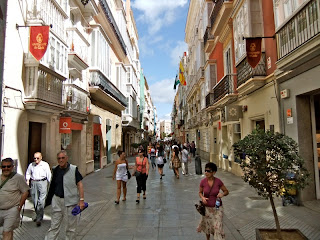Thursday, June 2, 2011
Iberian Peninsula, Atlantic Coast
May 30 - June 2. We visit towns on the Atlantic coast of the Iberian peninsula. The sea is rougher than the Mediterranean or Indian Ocean, which I find a welcome change - nice to feel some movement again, to remember that after all, I'm on a boat.
First stop is Cadiz, Spain. Population 130,000, a shrinking city due to job losses and the land limitations of a narrow peninsula. Nearby Jerez is the place where sherry was first made and is still made there. Cadiz is in a region called Andalucia. It is a vast olive growing area, responsible for much of the world's supply of olive oil. The great military leader Hannibal set up operations here around 200 B.C., tried to buy real estate, but was outbid by the Romans. It is still an important naval center and was once an important shipping port. It is a pleasant place to visit. We see an authentic flamenco performance, very impressive - a dance form native to Andalucia. Wander around the town, typical small Spanish city, quiet, pleasant, lots of old buildings, monuments, places to eat. Some of the passengers instead take the longer bus ride to visit the larger city of Seville, the capital of the Andalucia region of Spain.
Next day we visit Lisbon, capital of Portugal. Sailing into Lisbon, one cannot help but think of San Francisco, the starting point of our cruise. As we leave the choppy Atlantic to sail up the Tagus river, we pass under a suspension bridge called 'The 25th of April Bridge', looks nearly identical to San Francisco's Golden Gate Bridge. It was in fact built by the same company, since both locations require serious earthquake engineering. Another very similar bridge was built in Istanbul. Like San Francisco and Rome, Lisbon is known as a city of 7 hills. It has cable cars similar to San Francisco. It has a history of big earthquakes, with the most famous one occurring in 1755.
Lisbon and its surrounding metropolitan area is home to 30% of the country's 10 million people. Of course 'Lisbon' is the English name for this town. Locals call it 'Lisboa.' With its red tile roofs and light colored low-rise limestone buildings, Lisbon is an attractive place. The day before our arrival they have rain, but for our visit the weather is perfect. Our guide claims that to protect their buildings from humidity, the people in this part of Portugal cover the outside of their structures with ceramic tile. Portuguese like to use tile whenever possible. In fact porcelain and ceramic tiles are two of Portugal's well-known exports, a story that goes back to the days of the Portuguese explorer, Vasco de Gama.
On tour we visit the former royal palace, a massive building with more rooms than I can count. Every possible surface is elaborately furnished and decorated. A sort of mini Versaille, no expense was spared in creating this abode. It appears that while the King was busy bossing people around, his wife was busy spending all of the empire's money. No wonder the Portugese empire collapsed.
I finish my day in Lisbon on board the ship, with friends on the deck outside the Veranda dining room. We spend a long lazy afternoon, sipping coffee, not counting desserts, gazing at the beautiful hillsides of Lisbon and the wide Tagus river. Weather is perfect, a most pleasant afternoon. Finally, like life itself, it's time to leave, to sail once again for another port.
We sail through the stormy Bay of Biscay, where the warm Gulf Stream brings moderate temperatures to Europe as it flows north. Without this ocean current, most of Europe would be an icebox. Slowed by the strong headwinds, we miss our scheduled stop in Bilboa. So no Guggenheim Museum. Instead we visit Santander on the north coast of Spain. I walk for a few hours to check out the town. It's a compact city of about 180,000 people, set on a hillside overlooking a bay. It has sandy beaches, attractive, cohesive architecture, lots of people out walking, lots of sidewalk cafes and restaurants. There is a harbor with plenty of small boats, some sailboats on the bay. More space is alloted to pedestrians than to automobiles. Traffic is moderate. Along the water is a wide path filled with people. Despite the sheer drop of 15' to the water, there is no railing to prevent people from falling off the path. This gives the appearance of a city that believes people should be responsible for their own behavior.
I leave Santander and the Iberian peninsula, nearing the end of this 145 day adventure.
(photo at top of page is along harbor of Santander)
Flamenco dance in Cadiz
Street in Cadiz
Beach in Cadiz, sand is finer than Mediterranean
Bridge over Tagus river in Lisbon
Home Sweet Home for Portuguese Royalty
Lisbon
Cable car in Lisbon
Portuguese like their tiles
Tile covered building in Lisbon
Santander
Santander
Subscribe to:
Post Comments (Atom)

















No comments:
Post a Comment